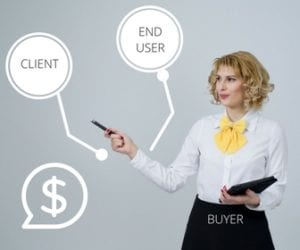The Three Clients of B2B Sales
Take a business that sells to other businesses (B2B, or business-to-business). Ask any three employees who their clients are; chances are you will receive three different answers. And, most likely, all three are correct.
How to increase sales from enterprise clients?
This questions rose recently on an online small business forum, from a provider of Business Intelligence software. They asked about how to approach, pitch and close a deal when selling to other businesses.
Business to business sales is a multi-layered thing. My answer to the above question comes in two parts, and I am going to share the first part of the answer with you today.
One Client with Many People
This first part is about understanding all of the influences affecting the buying decision. The better you understand how the buyer fits into an overall structure, then the better you will be able to communicate with him or her.
If you are a business that sells to other businesses you are already aware that there is no quick sale, so when you are selling to another business, bear in mind these three levels of client.
One – The Client Organization
Your client: the type of organization to which you sell.
For example: you sell to fitness centers; you only sell to law firms; you only sell to virtual businesses with fewer than 25 employees; you only sell to local business with at least 100 employees.
Industry, size and location are all ways to define the organization to which you are selling. And your client is that organization.
 Two – The Buyer
Two – The Buyer
Within that organization it is a person who is doing the actual buying.
To be precise, in a B2B environment you are dealing with consensus buying, which means that there is not one individual with complete decision-making power. There are many people involved. In fact you will be dealing on average with 5.4 different individuals. And the more people involved, the more complicated the process and the slower it is.
Having said all that: different people in that process have different roles. And there is going to be one individual who stands out as your principal buyer. Find out who it is in that buying group whose main responsibility is going to be attached to your product or service.
Nurture your relationship with that person: he or she will promote your product internally, be a gate-opener to the rest of the company, and that is the person you best want to serve.
Three – The End User
Your client’s client.
In a B2B environment, most buyers will also have an internal client: the end user. This, more often than not, is the front office, or the area generating revenue for the client organization.
To find the end user start with your Buyer, and then look at the Buyer’s responsibilities within the Client Organization. Whom is the buyer serving internally? That is the end user. You may never have direct contact with the end user, but your Buyer is responsible for helping the End User.
In Conclusion
In summary your B2B clients are three clients in one: the organization which is your client, the individual buyer with whom you are working, and the end user who ultimately benefits from your product or service.
The Buyer, sitting in the middle, is the focus of your energy. The more you understand how that buyer fits into their organizational structure, and how they serve their own end clients, the better you will be able to advise that person and sell them a product or service that meets their needs. In a future post we will talk about ways to better understand the buyer.
For now: if you are selling to businesses, understand these three levels so you can communicate with your buyer understanding his or her work context.
If you are buying for your organization, then expect them to understand these three levels. Expect them to properly understand what they sell, to whom and why.